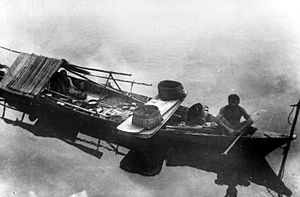Orang_Laut
Orang Laut
Ethnic group of Southeast Asia
The Orang Laut are several seafaring ethnic groups and tribes living around Singapore, peninsular Malaysia and the Indonesian Riau Islands. The Orang Laut are commonly identified as the Orang Seletar from the Straits of Johor, but the term may also refer to any Malayic-speaking people living on coastal islands, including those of Mergui Archipelago islands of Myanmar and Thailand, commonly known as Moken.
You can help expand this article with text translated from the corresponding article in German. (September 2017) Click [show] for important translation instructions.
|

The population of this tribe is estimated in the 21st century to be 420,000 people.
